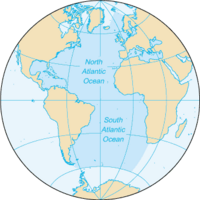
Photo from wikipedia
Abstract Standardized catch rates calculated from commercial fishery data have been used for many years to inform production models, which are usually the basis of stock assessments whenever data are… Click to show full abstract
Abstract Standardized catch rates calculated from commercial fishery data have been used for many years to inform production models, which are usually the basis of stock assessments whenever data are limited. Statistical theory implies that precision should increase as we gather more informative data about the process. It is therefore expected that the precision of population parameter estimates should increase as catch rate series increase in length. Does this actually occur? We explore whether new catch rate data, added each year improve the ability to assess stocks using a Bayesian state-space version of the production model. One can assess how much we have “learned” about the parameters of interest by comparing estimates calculated from shorter time series with those from longer time series. That line of reasoning is applied to datasets for swordfish of South Atlantic. Most of the results suggest that standardized catch rates added during the last two or three decades did not result in a significant gain of knowledge regarding model parameters.
Journal Title: Fisheries Research
Year Published: 2019
Link to full text (if available)
Share on Social Media: Sign Up to like & get
recommendations!